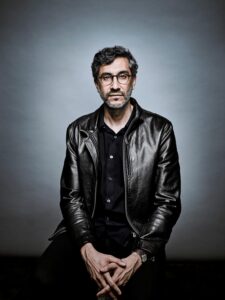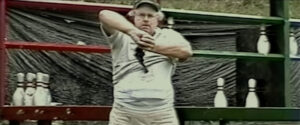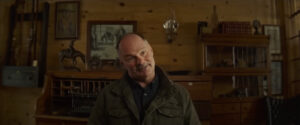Interview with “Second Chance” Director Ramin Bahrani
Written by: Christopher Llewellyn Reed | December 14th, 2022

In his first-ever feature documentary, Second Chance (which I reviewed out of DOC NYC), longtime indie veteran Ramin Bahrani profiles the ups and downs of Richard Davis, founder of Second Chance Body Armorand inventor of a bulletproof vest that proved extremely effective at saving many lives over many years. He is also known for shooting himself almost 200 times to prove the effectiveness of his creation. An eccentric businessman, Davis has seen controversy, as well, switching to inferior materials in the 1980s and facing scandal as a result. The movie is now in theaters and will come out on Showtime in the spring. Just last week, I had a chance to talk with Bahrani via Zoom. What follows is a transcription of that conversation, edited for length and clarity.
Christopher Llewellyn Reed: You’ve had a great run as a director of fiction films up till now. How did you decide that this was the time for you to do a feature documentary?
Ramin Bahrani: Well, I had made two short docs in recent years. And Werner Herzog had seen the first one I made and thought I had a knack for it and encouraged me to make more, which of course is good and gives you courage to do it. And I had been looking for a feature doc but had been so busy with the fiction work that …
I was editing The White Tiger in 2020 and the producers of what became Second Chance approached me with the material and asked me if I wanted to make a fiction film; they were going to pursue the documentary. And when I looked at the material, for thematic reasons I was very interested in the story and I understood why they thought I might be. What pushed me into wanting to do it as a doc was the treasure trove of archival material. So I just approached them back a week later and said, “What about me doing the doc instead of a fiction film?” And then they thankfully accepted and that’s how it happened.

CLR: Let’s talk about that treasure trove of archival material. What attracted you so much about it?
RB: They showed me some of the archives of Richard shooting himself, which is startling to look at. At first, I was thinking how I could recreate this better than seeing the real thing. Ultimately, I watched Richard’s eight-hour epic film, which is a series of basically shorter films—some marketing, some propaganda—with quite fascistic themes behind them, and others, featuring both broad comedy and narcissism, where Richard is the hero. And I saw some of those and then I started reading the basic outline of his life, as well as some legal documents, and I could see there was a moral crisis in the film. I saw American salesman and rags to riches, which are themes that I’ve explored in my own fiction work, and that was enough to compel me that there was enough material for a strong character and a thematically rich story.
CLR: Did you know the producers beforehand? Why did they pick you?
RB: I think they thought I’d be interested in the themes of the film: the American dream, the moral crisis at the center. I’ve done a lot of films that involve, let’s say, types of subcultures you don’t typically see in a movie, be it a push-cart vendor or evictions. So I think they thought I’d be intrigued by those things and they were right, I was. So then it was just about embarking on the first long-format doc. The first one I did was 7 minutes, the next one I did was about 25 minutes, but obviously, it’s a different ballgame when it has to be 90 minutes.
CLR: You paired up, however, with an editor, Aaron Wickenden, who has done a lot of great documentaries that I really love, like Feels Good Man and Hail Satan? How did you find Aaron and decide to work with him?
RB: Yeah, I like those films. I like his films with Morgan Neville, as well. He came recommended by a friend of mine, a doc producer, Maureen Ryan. I think they had worked together on the Michelle Obama film, Becoming. Maureen had also done Man on Wire and other films, and she recommended him. And as soon as I talked to him, we just kind of clicked. And of course I was impressed by his résumé, but I was even more impressed by him. He was very jovial but also very sharp and fast. He was a quick thinker, which I like, and kind of relentless. He would wake up and call me early in the morning; he was in Chicago and I was in New York and we were doing it remotely. And he always woke up and said, “I’ve got five ideas.” I’m like, “My God, he’s just woken up and he already has five ideas!” So he was really sharp and smart and an excellent editor of story and character and pacing and rhythm.
And I think in the edit, both of us were really grateful to have two very long Zoom calls with Joshua Oppenheimer, who saw our first cut. We kind of hit a wall and didn’t know what to do with the film. We knew there was something good in it, but we hadn’t found the right way to do it yet. I had broken the film up into chapters, as I had always imagined it that way. And it was a great call with Joshua, and he responded to everything he loved in the film, which was a lot. And then he was kind of encouraging us to let certain things go. And I think those things were a structure that I had in my mind from before we shot the film. And you’ve got to let those things go and let the film find itself and reemerge and be rewritten in the edit room.

CLR: Speaking of that structure, you have those six chapter headings and the epilogue and you say that you always intended it to have something, maybe not that or maybe exactly that. How did you land on that structure and why was that so important to you?
RB: Well, there were so many strange twists and turns to Richard’s story and I didn’t want to lose them because they were so telling of his character. More than story, I was interested in character and theme. And so the chapters allowed me to explore those themes in those moments in his life without losing the audience, in terms of where the film’s going. The only change that really happened in the structuring, or number, of chapters was that in the end we decided we’d better call the last chapter epilogue so it’s coming to an end and you’re not wondering how much further it will go. But in terms of the structure, when Joshua saw that, his advice was to let go of the rise and fall structure and to dig in more specifically to what each chapter is about. And that kind of helped us go back and reimagine how we would put each chapter together.
CLR: That’s interesting. Why Joshua Oppenheimer as a go-to advisor? That’s a great choice, but why him?
RB: Joshua and I are friends and he’s obviously a great filmmaker. And he’s very empathetic and also very intelligent, which is not a common combination, and very generous. He had also Executive Produced a short doc I made called Blood Kin and he was just willing to give us a little bit more time than most busy filmmakers can do, and we’re grateful for that.
CLR: I really like the epilogue. And I really like that moment between Aaron Westrick and Clifford Washington, the man who shot him. It’s extremely moving. I don’t know when in your process of filmmaking you came across Clifford’s story, but did you always intend to have that be the emotional punch at the end or did that just come as you went?
RB: It came in the filming. We initially shot in November 2020. It was my first airplane ride after COVID hit. So we shot in November and the first round of interviews was done in November. And Aaron Westrick, the police-officer-turned-whistleblower and Richard Davis’ employee, started telling me a little bit about Clifford. He had spoken to him on the phone about 10 years prior but they had not stayed in touch. Someone glimpsed someone at a local high school football game, a phone call was made, and suddenly they’re talking on the phone and then … never again and never meeting again.
And the more I learned about him, the more I thought, “My God, how foolish I was never to think he should be a character in the film.” And I asked the producers to please find him. And he was smart and intelligent and articulate and also funny. He had a great humor about him. And so we went back in April to film more interviews and by then, after the interview, it had occurred to me that this should be the end of the film and he would be a late guest to the dinner party and that’s kind of where he always was. Of course, Aaron [Wickenden], as a good editor, tried to bring him in earlier and we looked at that but we didn’t think it worked as well.

CLR: Well, as a viewer I think it works, because we know Aaron Westrick’s story to some degree, but it’s not like it’s front and center in our minds the whole time, and then you bring it back. Now, speaking of Richard, given the complicated nature of your portrait of him, did you ever have any issues with him perhaps not liking how he was being portrayed?
RB: No. He liked being in front of the camera. And I respect him, I respect what he did. I think he was brave and ingenious to make that device and he saved thousands of people. Obviously, he’s made some, at best, morally questionable decisions and has philosophies that I personally don’t agree with. But he was always game to talk. He wasn’t always game to go to answer certain questions, as you see it in the film. He just doesn’t want to accept certain things; there’s a wall of cognitive dissonance there.
And I think what surprised me when I went there was I thought he would be more self-reflective and forthcoming, emotionally and philosophically, about his life and what he had done. But he wasn’t really, and that initially startled me because I didn’t know what the movie was going to be otherwise. I realized I was talking to someone who won’t really dig into what has happened in the past, he will simply ignore it or go on the surface of it. And it wasn’t a question of him being able to, I just don’t think he’s wired that way. He only really got emotional around people he hasn’t saved, cops he hasn’t saved; that’s what would make him weep. And he would get a little bit emotional about his first wife.
CLR: I love both ex-wives. They’re a lot of fun.
RB: Especially the second ex-wife, Kathleen, she was so eloquent and poetic and deep. And she has such a different worldview than Richard, so that helps us understand him and it helps us understand what he believes and thinks by seeing something so different.

CLR: And his son is quite interesting, too.
RB: His son Matt is a super intelligent, very successful businessman. They’re pretty different.
CLR: And how is their post-Second Chance business going these days?
RB: Armor Express is very successful. I think Matt has sold it and he might just be on the board now, but it was very successful.
CLR: Prior to making this film, did you yourself have any personal experience with guns or bulletproof vests, or was that all new for you?
RB: No, I mean, I’ve shot guns at a gun range before, when someone invited me. And I’ve shot rifles in the country in North Carolina; where I’m raised, people typically have guns. But I’m not personally a gun enthusiast. I don’t own guns and it’s not really my thing.
CLR: So I also really like how the film is shot, from the interviews to the observational footage that’s not archival. How did you find your cinematographer, Adam Stone? He has a diverse set of credits of both fiction films and documentaries. He shot the fiction film Loving and the doc The Great Invisible. Did you know him before?
RB: Yes, I know Adam from North Carolina from 20 years ago. He was at the School of the Arts in my hometown ,Winston-Salem. And that’s where he met Jeff Nichols [director of Loving], who was also a student there. And he shot all of Jeff Nichols’ fiction work and then The Great Invisible and the Netflix doc series Wild Wild Country. And Adam had shot a commercial for me once and he also shot my first short doc. And I just was like, “God, I hope he’s available because he’s so skilled.” I thought he could help bring a cinematic quality to the film. He knows those kinds of places and the people and is just super great to work with.
CLR: Great talking to you. I wish you all good things with the movie.
RB: Thanks!


